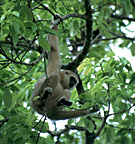January 07, 2008
Anthropologist brings field experience to classroom
CARBONDALE, Ill. — Ulrich Reichard left the jungle for the classroom when he came to Southern Illinois University Carbondale just over a year ago.
He brings some of the lessons he learned in Khao Yai National Park in Thailand to Southern Illinois this spring in his survey course on primates. The course meets only in the second half of the semester, beginning in mid-March.
Reichard, a biological anthropologist, devoted the majority of his scholarly life to studying a large community of white-handed gibbons in Thailand. He earned his doctoral degree in 1995 from the University of Goettingen in Germany. He was part of the prestigious Max Planck Institute for Evolutionary Anthropology in Leipzig until he came to SIUC. As part of his research while at the institute, he spent considerable time in the field in Thailand studying the gibbon communities.
Gibbons belong to the ape family. They are often referred to as "lesser apes" because they are smaller than the "great ape" families, which include gorillas and chimpanzees. Reichard's interest in gibbons is anthropological – he studies their ecology, behavior and cognition specifically to shed light on the possible ecology, behavior and cognition of our earliest ancestors.
"This is the only way we can try to reconstruct aspects of human evolution that do not leave an archaeological record – things like cognition and sexual and social behavior," he said. "It is the only way to access the distant past through the present."
Apes make good subjects for this kind of study partly because they are closely related and are similar to other early hominids, including those that became the genus homo, to which modern human beings belong. For example, Reichard said, chimpanzees today and Australopithecus three million or more years ago have similar brain size. That, and other similarities known from the fossil record, makes study of ape behavior today relevant to anthropology – the study of human beings from the very beginnings to the present.
Reichard stresses his research is topic driven, not species driven. In addition to studying white-handed gibbons, he also studies pig-tailed macaques and plans to study the endangered pileated gibbons as well. While he studies all aspects of behavior, he focuses on monogamy – what causes monogamous behavior and what results from the behavior. The probable social structure of our early ancestors is a hot topic among anthropologists. Did they live in large family units? In pairs? Did males contribute to child rearing? Looking at how different ape species live can provide clues about how our ancestors lived.
"We are looking at similarities and differences," Reichard said. "We look at how body size relates to behavior, the effect of different environments and different social functions."
It's a way to figure out, partly through long-term observation, partly through process of elimination, why similar species behave differently. What are the determining factors – size? environment? What are the advantages of family structure versus living in pairs? How might these things relate to what we know about our early ancestors? And, noted Reichard, it also helps answer the question: What makes us human?
Reichard brings his experience, passion and Thailand connections to his classroom. Already his research has opened up new understanding about social and mating behavior in gibbons. His database promises to open new research projects – some of which may involve SIUC students.
The undergraduate course this spring uses film and lecture to engage students in the lives of primates, from lemurs in Madagascar to marmosets in Amazon and, of course, gibbons in Thailand. Reichard said students will learn about primates – how they live and the challenges to their survival in this modern world – and also about themselves as they see behavior in other primates that may seem familiar.
Reichard said he is excited about sharing the secret lives of apes and other primates with his classes, but his jungle days are not over either. He accompanied SIUC doctoral student Chihiro Shibata to Thailand to help her settle in to her first field research trip. Shibata recently returned from several months in Khao Yai, bringing home observation sheets and other data to share with Reichard.
"I've always felt very comfortable with the gibbons in Khao Yai," he said. "I've spent more time there than in any human habitation. I think some of the gibbons know me by my footsteps. But one of the fantastic opportunities for me here at SIUC is working with graduate students. I always felt that no matter how nice it is to research, it is necessary to have students."
Caption:
Research lab — A white-handed gibbon in the forest at Khao Yai National Park in Thailand contemplates its environment while Southern Illinois University Carbondale assistant professor of anthropology Ulrich Reichard contemplates it. Reichard researches human evolution, using the behavior of modern apes like gibbons to help him understand how our earliest ancestors may have lived.
Photo provided by Ulrich Reichard
White-handed gibbon — A white-handed gibbon, one of the subjects of anthropological research conducted by Ulrich Reichard, assistant professor of anthropology at Southern Illinois University Carbondale, in its forest home in the Khao Yai National Park in Thailand. Reichard said he doesn't have many pictures of himself in the forest because he is usually the one behind the camera.
Photo provided by Ulrich Reichard


